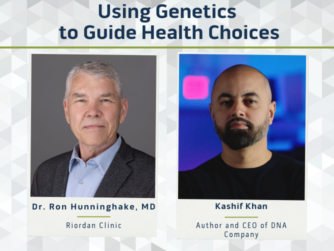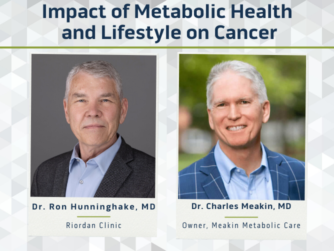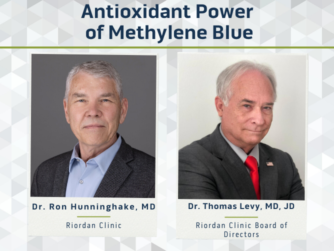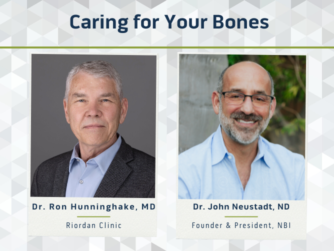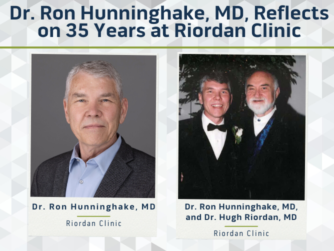In this episode of the Real Health Podcast, Chief Medical Officer Dr. Ron Hunninghake, MD, and Dr. Thomas Levy, MD, JD, revisit the topic of methylene blue. They address the themes of some of the nearly 400 questions and comments received after their March episode, including how methylene blue works, how to take it, and general suggestions for dosing.
Watch the Video
Thanks to this Episode’s Sponsor
Riordan Clinic Nutrient Store: https://store.riordanclinic.org/
Links
Learn more about the hosts: Dr. Ron Hunninghake: https://riordanclinic.org/staff/ron-hunninghake-md/
Dr. Thomas Levy, MD, JD: https://riordanclinic.org/staff/thomas-levy-md-jd/
Learn more about Riordan Clinic: https://riordanclinic.org/
Interested in becoming a Patient: https://riordanclinic.org/request-an-appointment/
Read the Transcript
Disclaimer: The information contained on the Real Health Podcast and the resources mentioned are for educational purposes only. They’re not intended as and shall not be understood or construed as medical or health advice. The information contained on this podcast is not a substitute for medical or health advice from a professional who is aware of the facts and circumstances of your individual situation. Information provided by hosts and guests on the Real Health Podcast or the use of any products or services mentioned does not create a practitioner patient relationship between you and any persons affiliated with this podcast.
Intro: This is the Real Health Podcast brought to you by Reardon Clinic. Our mission is to bring you the latest information and top experts in functional and integrative medicine to help you make informed decisions on your path to real health.
Dr. Ron Hunninghake: Welcome everyone to another episode of the Real Health Podcast. This is Dr. Ron Hunninghake, and I’m your Chief Medical Officer here at the Riordan Clinic, and we are excited to, once again, welcome back Dr. Thomas Levy, who is one of the foremost experts in redox medicine. And today we’re going to be talking about methylene blue again, because three months ago, we did a show on methylene blue, the antioxidant power of methylene blue. And since that time there have been 2,589 views with over 392 comments made. So, Dr. Levy, I think we created quite a stir there. What’s the deal?
Why is there so much interest in methylene blue, and what can we do to tell the audience more? Because it sounds like they’re really interested in what this can do for them.
Dr. Thomas Levy: Well, I think it’s probably because it’s methylene blue, a dye, which is kind of quirky if you will, at the outset and sort of immediately begs for a little attention how is it that some sort of dye is something that’s useful. And then of course, after you get above the surface there and get into the substance of it, you realize it’s just an incredibly dynamic therapy. And as we’ve discussed, and not all antioxidants have this property. I might add an antioxidant is not an antioxidant, it’s not an antioxidant, but methylene blue in many ways parallels the activities of vitamin C in the body and what it does and the effects that it has on increased oxidative stress inside cells and oxidized biomolecules, and along with some unique and increased activity over vitamin C when it comes to problems with the central nervous system.
Dr. Ron Hunninghake: Let me just read here. It’s been looked upon as a nootropic, which that is something that helps the brain, improved mood, improved energy, enhanced cognitive function, a greater sense of wellbeing. It’s safe. And as you mentioned, it’s a very powerful antioxidant, and it seems to work a lot in the central nervous system. So what is it that makes it different from vitamin C that makes it so useful in terms of cognitive functions?
Dr. Thomas Levy: Well, as we just mentioned, it is a powerful antioxidant. And generally speaking, for any condition that you want to get effective clinical outcomes, you want to have a way of delivery, whether it’s vitamin C or anything else, a very powerful antioxidant effect in the tissue that’s involved. So with that in mind, it turns out that methylene blue has fat-soluble characteristics. It has water-soluble characteristics. It’s not that large a molecule, and it very, very rapidly gets taken up into the cells throughout the body. And some of the literature says that it gets up to 100-fold more concentrated inside the central nervous system than the rest of the body, only an hour after administration. So it really likes the central nervous system. And early on it was discovered by a number of people who worked with it, including Dr. Paul Ehrlich, a Nobel Prize winner was that, wow, some people who were depressed just started losing their depression after they took methylene blue.
Dr. Thomas Levy: Now mind you, they didn’t go straight to giving people that they did a lot of animal research before it ever occurred to them to do something as crazy as give a dye as some sort of therapeutic agent. But the dye part is also beneficial in a lot of different applications because of two things. As I said, it’s well absorbed. And number two, the dye tracks things. So when surgeons have used it for a long time and showing exactly where cancers and other processes have infiltrated because they put a little methylene blue on the area, and it immediately gets taken up along the tracks of lymphatic vessels and other extracellular areas. So it allows surgeons to very well demarcate exactly where a condition – tumor, whatever is that they want to cut out. But as it turns out, and we can go this in a little bit, probably the single most important characteristic of methylene blue is that it rejuvenates mitochondria. If you rejuvenate mitochondria in the brain, magic starts to happen. People with neurological disorders that are felt to be irreversible are not irreversible. It just turns out they’re irreversible when traditional methods of treatment are used to treat them.
Dr. Thomas Levy: If all you do is concentrate on trying to suppress or minimize the symptom while really doing absolutely nothing in your primary therapy to stop the ongoing new damage and reverse the old damage of whatever process you’re looking at, of course, many diseases will be deemed incurable. But when you begin to understand the pathology, understand the importance of what you mentioned, redox biology, where we finally start to get the reduction, which is the electron replete in the electron’s side of redox, more prominent inside of cell than the electron depleted oxidized cell. When you start to have more reduced biomolecules than oxidized biomolecules, then incredible things start to happen.
Dr. Ron Hunninghake: I think if I just take a moment here and explain to the audience how I make my own methylene blue solution to take, because that was a number of the comments were, “Now, how do you make this stuff? What’s the best way to take it?” And there’s a lot of different ways, but I think this particular way elucidates what you just said, if you want to make yourself a methylene blue drink, what you do? What I do is take some warm water, warmer hot water, and I put ascorbic acid in the water, maybe a half of a teaspoon, and then I’ll take my pharmaceutical grade methylene blue drops that are available off the internet, and I’ll put 20 drops in, which is 10 milligrams of methylene blue. Interestingly enough, as it drips in, it’s dark inky blue, so you have to be careful how you handle methylene blue because it can really stain stuff. It’s dark and inky, but it starts to react with the vitamin C water, and it turns into leuko methylene blue, which is a kind of a very light, kind of blue or turquoise color. And it’s fascinating to see the color metric change that occurs. Now, Dr. Levy, why is that important to have a methylene blue that now owns an extra electron? What does that do to help the cell function better, especially cells in the brain?
Dr. Thomas Levy: Well, it does twofold things. In becoming reduced, it oxidized some of the ascorbic acid that was in that solution, which means part of the ascorbic acid is now DHAA dehydroascorbic acid, and it just turns out serendipity, science, whatever, that ascorbic acid straight up is very poorly, if at all taken up inside the brain as-is. Instead, it is the oxidized form, DHAA, which goes rapidly across the blood-brain barrier and uses the glute transporters, which is the same transporter that’s used for glucose. It is facilitated by insulin the same way to get inside the cell. This then allows a much greater amount, percent of the vitamin C, to be readily taken into the brain.
Dr. Thomas Levy: Now, having said all of that, you still have, and this is something that I’ve really come to my realization fairly recently, but I think it’s very important. I mean, all my professional life, or at least the last 30 years has been focused on the fact that vitamin C is a powerful antioxidant because it donates electrons. That’s not so true that that’s what makes it a powerful antioxidant. Many, many, many molecules will donate an electron, but they don’t participate in the rapid two and fro, give up an electron, take an electron, give out an electron, take an electron. In the case of vitamin C, this is why it’s not so important whether you take it ironically enough in a reduced or oxidized form, it’s just important that you continue to expand the matrix of vitamin C and other antioxidant molecules in the body so that the electrons already present in the system have a great facility and being easily distributed throughout the cytoplasm and throughout the organelles. Because, literally, it’s whether electrons get where they need to go, inadequate amounts and time that determine health.
Dr. Thomas Levy: And just to mention something we already talked about in the past, but it’s important to realize is when electrons flow, that’s called current. Okay? So if you have enough antioxidants like vitamin C that not only will donate electron but will rapidly take the electron back when it’s, after it’s been oxidized, this actually generates a flow of electrons, gives you microcurrents and generates voltage potentials across a cell. And there’s many articles in the literature that clearly show that certain degrees of current and certain degrees of voltage are clear markers of whether a cell is healthy or not.
Advertisement: There’s a lot more to this conversation, and it’s coming up right after a quick break. Today’s episode of the Real Health Podcast is brought to you by the Riordan Clinic Nutrient Store. The nutrient store is your resource for the highest quality nutritional supplements. Every supplement in the store is handpicked by the expert medical staff at Riordan Clinic providing you with the best quality, purity, consistency, and effective dosing available. Visit store.riordanclinic.org to shop online.
Dr. Ron Hunninghake: So basically when people would take the methylene blue in this manner, you’re going to facilitate its entry into the central nervous system. And I ran into a shocking, amazing statistic. I used to tell people that a neuron contains about 100,000 mitochondria – one neuron. The new thinking is that it’s anywhere from 1 to 2 million mitochondria. So if you can get electrons via vitamin C and methylene blue into your central nervous system, that’s going to help what some days, to me feels like the dead battery syndrome, those days when my brain just is not working. But this is a good way to rejuvenate it. And there is research now in terms of Alzheimer’s and other Parkinson’s, other central nervous system diseases responding to this therapy, though it’s not a well-known therapy in conventional thinking.
Dr. Thomas Levy: They have something called the ORAC value, which is basically how quickly and completely an antioxidant gives up electron, but it does not measure in any degree at all how readily it takes it back, which is why you have some of these antioxidants, old astaxanthin and other that are so powerful, but they don’t get where you want ’em to get in the body. So it’s important that you have that power plus the ability to be distributed. And the one really super thing that makes methylene blue unique above and beyond vitamin C. It’s almost slander for somebody like me to say that right above and beyond what vitamin C can do is that it rapidly gets taken up not only inside the cells, but specifically inside the mitochondria. So it’s selectively accumulates inside the mitochondria. Now, what does it do when it’s there? Well, whether it’s in its reduced form or it’s oxidized form, when it finally gets there, either way, this is what happens if it’s in its reduced form. It bypasses the entire electron chain transfer series of complexes and donates the electron to the final one that allows the development of protons that fuel the A T P synthase pump, and you make a lot of ATP without all the stuff ahead of it.
Dr. Thomas Levy: Why is that significant? Well, in going through the entire electron transport chain, not only are you trying to get that electron down to that final spot where it needs to be, you’re generating more oxidative stress in the process. And this is what pretty much causes mitochondrial dysfunction is things slow down. You start to generate too much oxidative stress relative to the amount of energy that you generate, and then it’s a vicious cycle and things slow down and shut down the methylene blue goes straight to the end of it and allows you to make ATP without generating the oxidative stress. On the other hand, when methylene blue comes into the oxidized state, it goes to the first complex where there’s a lot of what’s called NADH. And the NADH instead of will directly give the electron and methylene blue, and then it’ll go to the other end of the train, do the same thing that I just mentioned and generate ATP. So even without needing or having to understand biochemistry at all, in a nutshell, methylene blue makes mitochondria, which are the powerhouses of your cells, which means that the powerhouses of your body makes mitochondria much more efficient in making energy and much more efficient in generating less oxidative stress in the process of generating that energy.
Dr. Ron Hunninghake: It’s pretty cool. Just for our general audience, in terms of dosage, we had a number of questions and comments about dosing. Well, first of all, are there any contraindications to using methylene blue, isn’t it the antidepressants theoretically could be a problem, and you may have to start really low in that case.
Dr. Thomas Levy: Well, they talk about the people who take the SSRI antidepressants. Even then, it doesn’t appear inevitable that methylene blue is going to give you problems. It’s just that under those circumstances, you should probably work with an aware integrated physician and maybe start at a low dose while at the same time tapering off of some of those drugs. But certainly if you’re on the SSRI, you shouldn’t just straight out of the gate take a large amount of methylene blue because that could cause substantial problems.
Dr. Ron Hunninghake: Yeah, and there are a number of the psychiatrists now, Dr. Christopher Plummer has written a book called “Brain Energy” where he’s making, he’s a Harvard psychiatrist researcher making the assertion that maybe all of your mental illnesses may turn out to be metabolic, namely lack of energy. And this is where the methylene blue story comes in. So people could easily, I would think, start with maybe five or 10 drops and make the vitamin C solution, and it has to be ascorbic acid. If you use sodium ascorbate, you’re not going to get the electron donor to the methylene blue, so it has to be ascorbic acid. Quarter to a half a teaspoon in some warm water, stir it up with the methylene blue, and then you can drink it, and it doesn’t dye your tongue, and it’s very well tolerated. What would you say, once or twice a day? I don’t know what the half-life is.
Dr. Thomas Levy: The half-life is significant. I don’t think you need to dose it more than once a day, unless you’re treating a condition, you’re dealing with an infection. We talked about in the past how effective methylene blue was amazingly as a monotherapy and bringing people out of advanced septic shock with covid on the ventilator with all vasopressors, and even after having coded and brought back. So if you’re dealing with an earlier stage or cold or flu or something along those lines, then you want consider dosing it several times a day. The dosage range, generally speaking, and I got to emphasize generally, okay, is something along the lines of 0.5 milligram per kilogram body weight up to maybe two milligrams per kilogram body weight. Now, what does that translate to? Well, if you’re 150 pound person, that’s 70 kilograms, so two milligram per kilogram, that’s 300 milligrams. That would be your top dose.
Dr. Thomas Levy: Whereas you’re low dose, you’re not really feeling poorly, you just want to keep things running, well, then you might want to go with the five or 10 or 15 milligrams, which would be 10 to 20 drops of the methylene blue. So all of that determines how you go after that. And then like everything else, people, just like they do with vitamin C, they develop their own health intuition. They notice many people, just like with vitamin C, after they take a little methylene blue, they feel better in a way that they can’t quite put their finger on, but they know when they’re feeling better, and they know when that’s not there. And so people just are able to adjust it based on how they feel. But basically, if you don’t go crazy on the dosage and don’t exceed a 100, 150, 200 milligrams, especially if you’re dealing with an infection, there’s very, very little toxicity. It’s been around a long time
Dr. Ron Hunninghake: Since I think over 100 years. So it’s always a good idea to try to develop a relationship with a knowledgeable person. I have one of the comments was the person mentioned it to their nephrologist and he says, “that’s crazy.” That’s crazy. Well, if you don’t know anything about it, it sure would sound kind of crazy, but if you use small doses working up gradually and also understanding the fact that Rome is not built in a day, and if you’ve got early stage or mid stage, it’s not going to make you well in a short period of time. There’s going to be a process of healing that needs to go on and should be coordinated, I think, with someone knowledgeable in the field of supplements and functional type medicine. But anyway, Dr. Levy, this is fascinating and I think this is not the end of the story.
Dr. Ron Hunninghake: I think more people are going to want to know more about it, because in a way it highlights what you’ve been saying for so many years is that antioxidants still play a crucial role, have always played a crucial role in not only regaining health, but maintaining optimal health. And so once again, I want to thank you for the work you’ve done for all these years and the work you’re still doing with the books you’re writing and the hope you’re giving to people as they look for ways to deal with their chronic illness. Thank you so much.
Dr. Thomas Levy: Well, thank you Dr. Ron. I appreciate that, sir.
Dr. Ron Hunninghake: Alright, we’ll be back sometime in the future. Everyone, take care.
Outro: Thank you for listening to the Real Health Podcast. If you enjoy this episode, be sure to subscribe and leave us a review. You can also find all of the episodes and show notes [email protected]. Also, be sure to visit RiordanClinic.org where you will find hundreds of videos and articles to help you create your own version of Real Health.



